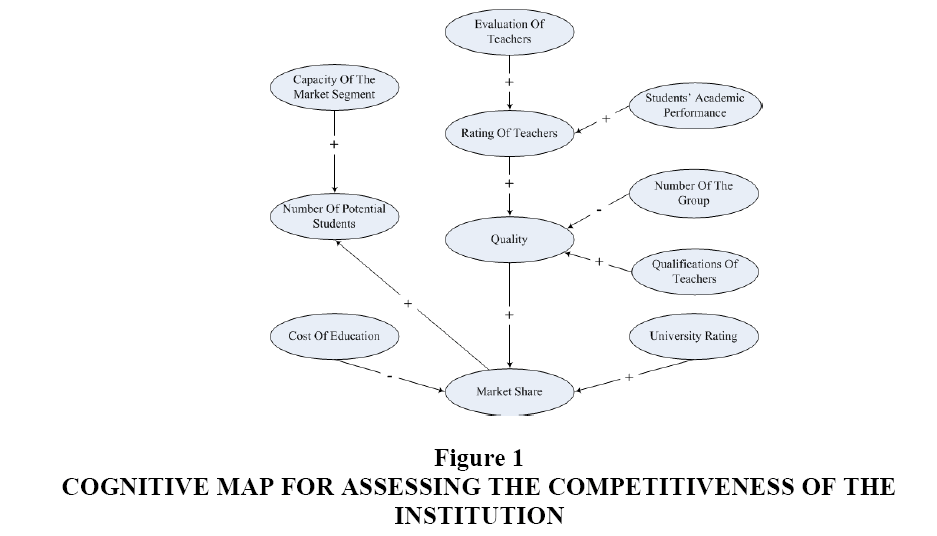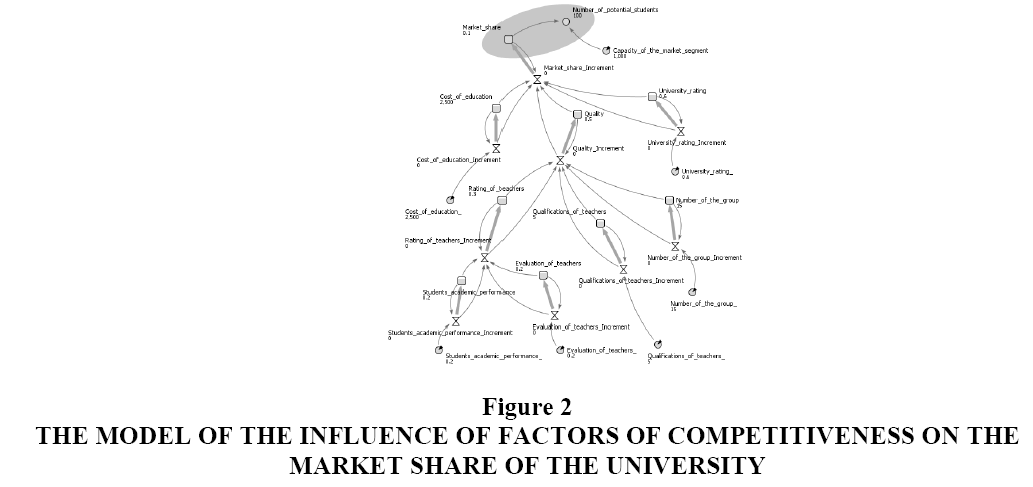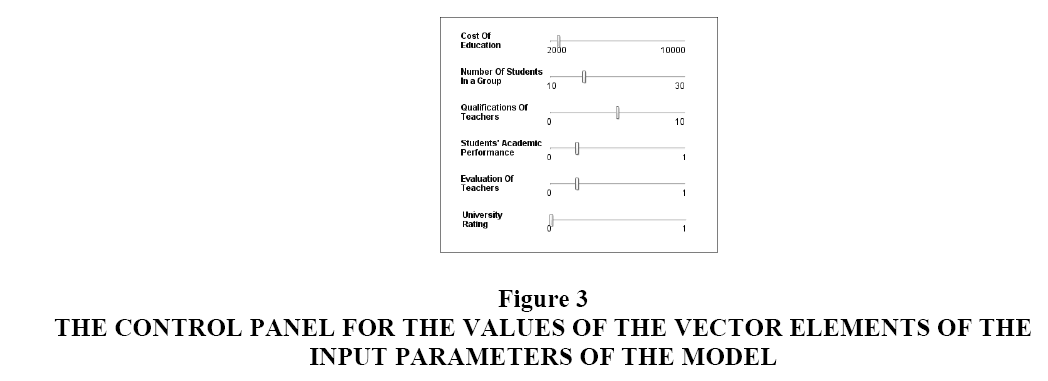Research Article: 2017 Vol: 21 Issue: 3
Competitiveness Calculation of Educational Services in Chinese City Zhenjiang
Admiral Makarov National university of Shipbuilding
Kostyantyn V Koshkin
Admiral Makarov National university of Shipbuilding
Alexander S Ryzhkov
Admiral Makarov National university of Shipbuilding
Rostyslav S Ryzhkov
Admiral Makarov National university of Shipbuilding
Abstract
The article proposes a methodology for assessing the competitive position of the university in the market of educational services, based on the development and application of the model of mutual influence of the factors of the university's competitiveness. An algorithm for assessing competitiveness is presented. The indicators of the activity of the higher educational institution that have the greatest impact on the competitive position of the university are highlighted according to the Pareto principle. A cognitive map of the situation that determines the mutual influence of the factors is constructed. A simulation model based on the integration of the principles of system dynamics and cognitive modeling, which allows the balancing of values of key parameters, is developed. The values of the model variables during the experiments can be changed, while determining the sensitivity of the vector of output parameters. Using a method based on specifying control points, a scale of characteristics for each factor has been developed. The results of modeling on the basis of real data are presented.
Keywords
Competitiveness of the University, Simulation Model, Cognitive Modeling, System Dynamics.
Introduction
In conditions of dynamic transformations of the higher school, rapidly changing economic conditions, improving the quality requirements of professional education, continuous updating of training technologies, increasing competition in the market of educational services there were problems of ensuring resilience, maintaining the financial state at a sufficient level and searching for sources of sustainable development before Ukrainian universities. It is necessary to develop and implement a strategy to increase the competitiveness of the university and its educational services to solve the problems that arise in conditions of instability and uncertainty of the external environment, a significant shortage of budget funding for higher education. International joint educational programs are an important tool for increasing the competitiveness of universities and, as a consequence, a factor in the development not only of regional but also national education systems (Danilova, 2006).
It is necessary to develop measures to improve competitiveness, make programs to enter new markets, form pricing policies, and attract investors' funds which will make the task of assessing the competitiveness of educational services relevant in the theoretical and practical aspects. The availability of the evaluation methodology, on the basis of which is possible not only to determine the competitive position of the university on the market, but also to predict the consequences of various managerial decisions and it will help to develop an effective strategy to increase the university's competitiveness.
There are a large number of researches, which are devoted to the problems of assessing the competitiveness of higher education institutions. The level of competitiveness of an educational institution in the market of educational services can be determined through various methods of expert assessments.
The procedure for carrying out expert research by the method of paired comparisons (Shannon, 1975) is carried out by a pair comparison of predetermined parameters of university competitiveness, with each subsequent evaluation not related to the previous one. The processing of all paired estimates form a matrix of paired preferences gives numerical values of the significance of competitiveness parameters for a particular institution. The method of rating evaluations uses an integral indicator of the success of the institution. This is a rating which is determined in accordance with different methodologies. The universities are compared by indicators that characterize their activities, the quality of educational services which provides higher education institutions in the conduct of the rating assessment. The methodology of integral assessment of competitiveness was proposed by Ryzhkov (2017). It is based on the theory of fuzzy sets and allows building ratings of universities with an additional classification of levels of competitiveness. Calculation of the integral indicator of the university's competitiveness, defined as the arithmetic average of the indexes of the modules, which have a different degree of significance, is the result of the score-rating complex estimate proposed by Koshkin (2016).
The authors of many publications define the competitiveness of educational services as a complex structure consisting of many factors. The methodology for assessing the competitiveness of educational services in terms of indicators, which are grouped as follows: technical, normative, economic are proposed by Grin'kevich (2013). A similar approach is used by the author by Fedulov (2005), highlighting three groups of factors: consumer indicators, which reflect the fundamental possibility of realizing services in a particular market; economic (the price of educational services); organizational (the credibility of the university, image, rating, accessibility of educational services).
The quality of the educational process is identified as a fundamental factor from the whole set of characterizing parameters in a number of works (Lyubavtsev, 2007; Timofeyev, 2006; Torgerson, 1958). This is a multi-component indicator, which is necessarily influenced by such parameters as the availability of highly qualified teachers, the average score of academic achievement, the ratio of the number of teachers and students.
Algorithm for Determining Competitiveness
The task of determining the value of the competitiveness index is one of the most difficult not only as the definition of attributes, but also the choice of methods for obtaining their quantitative assessment, which are shown by the analysis of scientific publications. A model that reflects the influence of factors of competitiveness of the university on each other is necessary to solve this problem, as well as forecasting tasks.
Thus, the purpose of the study is to increase the effectiveness of assessing the competitive position of the university in the market of educational services, based on the development and application of the model of mutual influence of factors of the university's competitiveness.
The analysis of scientific research devoted to the assessment of the competitiveness of universities has shown that different methods and tools can be used to determine the competitive position of the institution.
The main stages of the algorithm for determining competitiveness:
– Defining the purpose of the assessment;
– Definition of the types of activity considered in the analysis;
– Choice of reference database;
– Definition of characteristics that will change;
– Assessment of selected characteristics;
– Calculation of the generalized, integral indicator of competitiveness;
– Conclusion about competitiveness.
The effectiveness of the assessment of the competitive position of the organization depends on the choice of characteristics, the determination of their relative importance (weight in the total assessment, %) and the evaluation of these characteristics for the university and its main competitors, as can be seen from the algorithm (Warren, 2002).
The assessment of competitiveness can be conducted on the following parameters: market share, quality of products (services); price of products (cost of services); use of new technologies; prime cost of products (services); the quality of the management team, new products (services), the ratio of world and domestic prices; reputation of the organization (rating) and others.
The main indicator of competitiveness is the share of the organization in the market is the higher the markets share of a higher education institution, the higher its competitiveness. The market share and the growth rate of the market testify to the effectiveness of the university activity, which manifests itself in the demand for educational services that it provides. It can be concluded that the enterprise in the market is competitive with an increasing or unchanged share of the organization.
Simulation Model
Simulation model that combines the principles of system dynamics (Riznyk, 2013) and cognitive modeling (Vertil, 2002) is proposed to be used to analyze the mutual influence of factors of the university's competitiveness. The choice of development methodologies is the apparatus of system dynamics. It is also determined by an effective tool for modeling dynamic managed systems with a high level of abstraction and a multitude of feedbacks. The cognitive approach makes it possible to synchronize changes in parameter values and analyze the influence of model parameters on each other. Any Logic system, which combines the possibilities of creating hybrid models based on models of system dynamics, discrete-event models and the agent approach (Baryshev, 2005) was chosen for the development of the model.
Consider the process of assessing the competitiveness of the university as a dynamic
system with a discrete mapping. The mathematical model of such system is determined by the
state vector of this system  –the state of the system at time
ti, ti – discrete time, i=0,1,2,…, n; and also by the evolution operator Φ , which determines the
correspondence between the state of the system i x and its state xi+1 xi – the point of the phase
space, the coordinates of which are the values of the system parameters at the time ti. Initial state of the system x0 = x (t0). The change in the state of the system is described by the relation:
–the state of the system at time
ti, ti – discrete time, i=0,1,2,…, n; and also by the evolution operator Φ , which determines the
correspondence between the state of the system i x and its state xi+1 xi – the point of the phase
space, the coordinates of which are the values of the system parameters at the time ti. Initial state of the system x0 = x (t0). The change in the state of the system is described by the relation:

The state of the system under investigation can be described using classical approaches of system theory, in particular, cognitive modeling (Figure 1).
The cognitive model of a complex, weakly structured system is represented by a functional graph. The main factors (concepts) will serve as the vertices of the graph and the links between the mutual influences of the factors on each other are arcs.
The method is used to develop the scales of characteristics proposed by Ryzhkov (2017). It is based on specifying reference points (maximum and minimum value of a characteristic) and obtaining new values of the scale by dividing the segment in half with the interpretation of the midpoint in the domain. We obtain a linearly ordered scale of the set of linguistic values as a result of this procedure. The elements of the set are mapped onto a segment of the numerical axis (0-1). Point and its vicinity, which has the same linguistic interpretation is defined for each linguistic value on the segment of the numerical axis (0-1).
It is possible to solve two types of tasks, based on the cognitive model:
– Direct (determination of the degree of change of the resulting factors with a change in the initial factors);
– Inverse (determination of the necessary value of the change in the initial factors for obtaining the target value of the resulting factors).
Analysis of the cognitive map allows identifying the structure of the problem (system), finding the most significant factors affecting it, evaluating the impact of factors (indicators) on each other. Circle of problems to be solved includes an assessment of the attainability of goals, the development of scenarios and management strategies and the search for management decisions (Richard Koch, 2017), on condition allocation of target and input concepts, which can be influenced in the cognitive map.
We use the Pareto principle (Axelrod, 1976) to determine the parameters of the simulated system. It states that only a small part is significant from the set of factors influencing the result. The determining factor of the competitive position of the university is the market share and, as a consequence, the number of potential students, we will outline the key indicators that have the greatest influence on this parameter: the cost of education, the quality, the rating of the university.
The quality of the provided services is determined by the values of many factors, the most important of which are: the qualifications of teachers, the rating of teachers and the number of students in the group. The rating of teachers is a parameter that depends on the average value of students' progress and the average grade of teachers, which is obtained from the results of questioning of students (Vertil, 2002).
Rapid assessment of competitiveness on the basis of which is possible not only to evaluate the activity of the university, but also to develop specific measures to increase its competitiveness, is possible on the basis of using various approaches to simulation modeling. A model that will reflect the interaction of factors in the dynamics (Forrester, 1969) will be necessary for the development of management strategies and the search for managerial decisions.
We can single out the following conditions for the use of simulation models (Danilova, 2013):
– In cases where there is no complete mathematical formulation of this problem;
– Analytical methods are available, but they are very complex and time-consuming and simulation modelling provides an easier way to solve;
– Analytical solutions are available, but their implementation is impossible due to insufficient training of existing staff;
– It is necessary to monitor the progress of the process for a certain period, in addition to evaluating certain parameters;
– Simulation modelling can be the only possible because of the difficulty of setting up an experiment and observing phenomena in real conditions;
– It may be necessary to compress the time scale (both deceleration and acceleration).
The simulation model of the mutual influence of the competitiveness factors of the university (Figure 2) is a dynamic system that is determined by a set of parameters and a set of direct and inverse relations between them.
Figure 2: The Model of the Influence of Factors of Competitiveness on the Market Share of the University
Let’s enter the following notation for variables of the model of mutual influence of factors of competitiveness:
MCP (Сapacity_of_the_market_segment) – The total number of potential students in the direction in which the university prepares specialists, people/year;
CP (Market_share) – The share of the university in the total number of students in the direction in which the institution prepares specialists at the time, t (the normalized value is estimated in the range (0-1)), %;
PS (Number_of_potential_students) – Number of potential university students, persons; CE (Cost_of_education) – The cost of training per unit of time, RMB/year; Q (Quality) – Quality of training (normalized value, estimated in the range (0-1)), points;
RU (University_rating) - The rating of the university in this segment of the market (normalized value, estimated in the range (0-1)), points;
RL (Rating_of_teachers) - the average rating of the teaching staff (the normalized value is estimated in the range (0-1)), points;
QL (Qualifications_of_teachers) - the level of qualification of the teaching staff (standardized value, estimated in the range (0-1)), points;
NS (Number_of_the_group) - number of students in a group of one teacher, persons; SM (Students_academic_performance) - average score of students' progress (normalized value, estimated in the range (0-1)), points;
RLS (Evaluation_of_teachers) - the average grade of the teaching staff, obtained as a result of the questioning of students (the normalized value is estimated in the range (0-1)), points.
The values of the input variables CE, RU, QL, NS, SM, RLS can be changed by specifying, using the sliders, the values of the corresponding target parameters CE_, RU_, QL_, NS_, SM_, RLS_ (Figure 3) during the scenario analysis experiments with the simulation model.
Figure 3: The Control Panel for the Values of the Vector Elements of the Input Parameters of the Model
Changing parameters CE_, RU_, QL_, NS_, SM_, RLS_ in the mode of simple experiment, you can analyze the consequences of possible design solutions.
The state of the simulated system at time t0 is determined by the initial values of the set of parameters:

The initial values of the parameters that are specified in the model determine the market share and the number of potential students of the Admiral Makarov National University of Shipbuilding in Zhenjiang (China) (Table 1):
| Table 1 Represent Market Share and Number of Students of Admiral Makarov National University |
|
| MCP0=1 000 persons | CP0=0.1 %, |
| PS0=100 persons | CE0=2,500 RMB/year |
| Q0=0.5 point | RU0=0.6 point |
| RL0=0.3 point | QL0=0.5 point |
| NS0=15 persons | SM0=0.2 point |
| RLS0=0.2 point | |
The mathematical model is a system of equations:
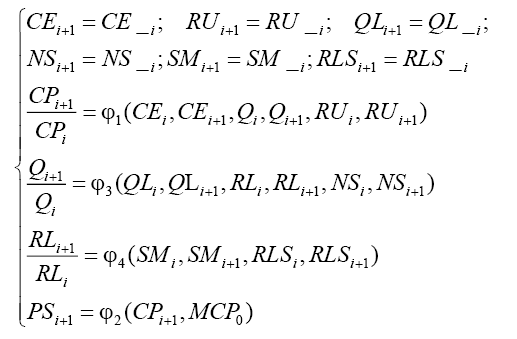
A collection of mappings {Φ1 , Φ2 , Φ3 , Φ4} is an evolution operator Φ that determines the correspondence between the state of the system xi and its state xi+1 .
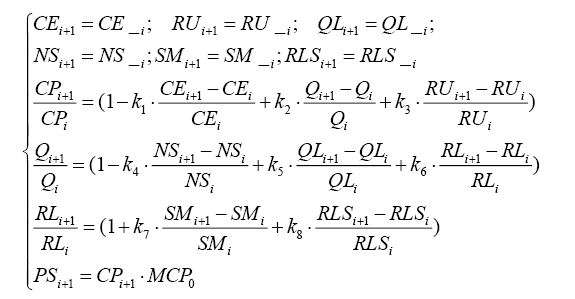
The values of the coefficients k1, k2, k3, k4, k5, k6, k7, k8 characterize the force of the influence of the causal factor on the factor of the effect [20] and are determined by the methods of expert assessments in the system of equations (2).
Conclusion
The main indicators which influence the evaluation of the competitive position of the university in the market of educational services were identified.
The interrelations between the factors are determined by considering the cause-effect chains (a cognitive map is constructed in the form of an oriented graph).Was developed a system-dynamic simulation model that makes possible to do a forecast concerning the number of potential students and the market share at the stage of designing educational services.
The application of the proposed approach and the developed model makes it possible to improve the effectiveness of the assessment of the competitive position of the university in the market of educational services on the basis of an analysis of the impact of competitiveness indicators on each other.
Further research should be directed to conducting experiments with the proposed simulation model to analyze the consequences of management decisions.
References
- Danilova, T.V. (2006). Methodology for assessing the competitiveness of universities. In Proceedings of the Scientific and Practical Conference, Quality and competitiveness in the 21st century, 59.
- Shannon, R.E. (1975). Systems simulation: The art and science, 368.
- Ryzhkov, A.S. (2017). Assessment of the quality of teaching as an element of the management of a joint international educational project. Science Rise, 51-59.
- Koshkin, K.V., Voznyi, A.M & Knyrik, N.R. (2016). Decision-making in the implementation of IT projects based on simulation, Visn. NTU KHPI, Ser. Strategy management, management of portfolios, programs and projects, 12-16.
- Grin'kevich, O.S. & Sorochak, O.Z. (2013). Application of the theory of fuzzy sets in the rating assessment of the competitiveness of universities.
- Fedulov, A.S. (2005). Fuzzy relational cognitive maps. Theory and Control Systems, 120-132.
- Lyubavtsev, A.V. (2007). Problems of assessing the competitiveness of educational services of higher education, Pedagogical sciences.
- Timofeyev, V.V., Renkas, N.N & Sharonin, Y.U.V. (2006). Rating of Russian colleges: From the methodology of definition to practice. Secondary Vocational Education.
- Torgerson, W.S. (1958). Theory and methods of scaling. 460.
- Warren, K. (2002). Competitive strategy dynamics. 346.
- Riznyk, N.M. & Bachynsˈka, O.M. (2013). Economy and region. 4(41), 64-69.
- Vertil, V.V., Germaidze, G.Y.E. & Zuyev, V.M. (2002). Requirements for the preparation of graduates as a factor of competitiveness of the system of secondary vocational education. 4(26).
- Baryshev, A.F. (2005). Marketing. 3rd edn, 208.
- Ryzhkov, A.S. (2017). Management Education Science & Society Technology, 5(2), 125-137.
- Koch, R. (2017). The 80/20 principle: The secret of achieving more with less. Nicholas Brealey, 302.
- Axelrod, R. (1976). The structure of decision: Cognitive maps of political elites. 422.
- Vertil, V.V., Germaidze, G.Y.E. & Zuyev, V.M. (2002). Requirements for the preparation of graduates as a factor of competitiveness of the system of secondary vocational education. 4(26).
- Forrester, J. (1969). Urban dynamics. 299.
- Danilova, S.V. (2013). Methodological assessments of competitiveness, Creative Economy, 4(76), 54-61.
